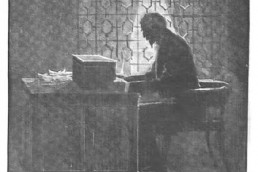The second half of the nineteenth century was arguably the golden age of the newspaper. Increasing urbanisation and rising literacy rates created a growing market for local news and entertainment, which entrepreneurs like William F. Tillotson were keen to exploit.
In 1871, with the repeal of paper duty, “men began to think about the possibility of a new halfpenny press” (Singleton, 1950, p.7). In November that year, Tillotson began to publish a weekly title alongside the Bolton Evening News; originally entitled the Bolton Journal and Guardian, it was quickly renamed as the Bolton Weekly Journal. It was the need to differentiate this weekly paper from its daily, sister-title that led Tillotson to begin the serialisation of fiction in its pages and to the creation of the Tillotson fiction bureau. Selling the serialisation rights to other provincial news titles offset Tillotson’s payments to his authors and generated additional profits. By the end of the decade, the bureau was syndicating novels and short stories in the Australian press and entered the American market in the early 1880s, followed by continental Europe in the late 1880s.


The rapid expansion of what rapidly became a publishing empire was also due to Tillotson’s openness to technological advances. In 1877, Tillotson’s own newspapers began to be published on a newly acquired rotary web printing machine. No longer needing to be fed by hand, the Victory machine could print 15,000 copies an hour.
As this new technology was embraced across the industrialised world, the insatiable demand for copy from the bureau increased. With the new rotary printing presses, newspaper publishers could be supplied with serialisations which required no typesetting. Tillotson’s would set the type at its Bolton headquarters, from which a papier-mâché mould would be cast, then produce a metal plate from the mould.
This plate could be supplied to a publisher in single column form, allowing the publisher to cut it into lengths that would fit the space provided for it in the newspaper. To minimise shipping costs, these plates were typically made of a light metal (usually aluminium) and could be sent by rail quickly and cheaply. For clients in the United States and Australia, however, the copy was usually supplied in the form of galley proofs. Even lightweight plates were simply too expensive to export on long sea routes, and galley proofs also had the advantage that publishers could edit or illustrate books to suit local tastes, which they often did.
The problem with the continental market was the language barrier. For the German market, which Tillotson entered with the opening of a Berlin office in the late 1880s, translators and compositors were employed at the Bolton headquarters, producing the plates that would then be shipped to Germany for inclusion in a number of regional newspapers. A key reason for the bureau’s European success was its ability not only to provide interesting copy, but in a format which publishers could integrate into their own titles with relative ease.
Bibliography
Johanningsmeier, Charles (1995) “Newspaper Syndicates of the Late Nineteenth Century: Overlooked Forces in the American Literary Marketplace”. Publishing History. Vol. 37, No.1, pp. 61-82.
Law, Graham (2000) Serializing Fiction in the Victorian Press. Houndmills: Palgrave.
Singleton, Frank (1950) Tillotson’s 1850-1950: Centenary of a Family Business. Bolton: Tillotson & Son Ltd.
Bibliography
Colby, Robert A. (1985) “Tale Bearing in the 1890s: The Author and Fiction Syndication”. Victorian Periodicals Review. Vol.18, No.1, pp. 2-16.
Hilliard, Christopher (2009) “The Provincial Press and the Imperial Traffic in Fiction, 1870s-1930s”. Journal of British Studies. Vol.48, No.3, pp. 653-673.
Johanningsmeier, Charles (1995) “Newspaper Syndicates of the Late Nineteenth Century: Overlooked Forces in the American Literary Marketplace”. Publishing History. Vol. 37, No.1, pp. 61-82.
Jones, Aled (1984) “Tillotson’s Fiction Bureau: The Manchester Manuscripts”. Victorian Periodicals Review. Vol.17, No.1, pp. 43-49.
Singleton, Frank (1950) Tillotson’s 1850-1950: Centenary of a Family Business. Bolton: Tillotson & Son Ltd.










